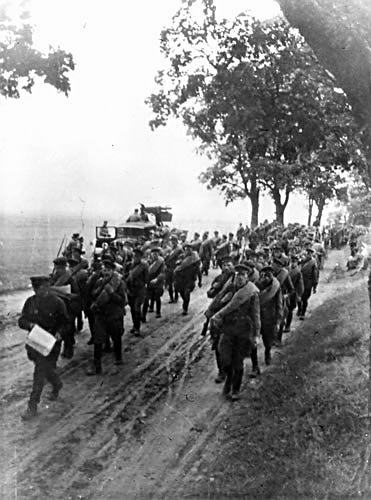
September 1st had the dubious distinction of marking the 80th anniversary of the German invasion of Poland and the start of World War II. Leaders around the globe marked the event in various ways.
An arguably even more critical event has received less attention — the second invasion of Poland on September 17, 1939 – this time by the Soviet Union.
By some estimates over 800,000 Soviet troops participated in this invasion with military operations lasting for twenty days. To avoid fighting a two-front war, Stalin’s order did not go into effect until one day after the Soviet–Japanese ceasefire, ending the border skirmish at Nomonhan ( a decisive Soviet victory).
Polish forces already overwhelmed in their struggle with Germany were no match for the Soviet aggressors.
The division of Poland between Moscow and Berlin was envisioned via a secret clause in the Molotov–Ribbentrop Pact of August 23, 1939, though the actual Soviet invasion created new realities on the ground. For example, Lithuania was supposed to be controlled by Germany under the plan envisioned in the Molotov-Ribbentrop Pact. Instead, the region fell under Soviet control as the Soviet Union used the war in Poland as a pretext to demand basing rights from the Baltic states leading to their eventual annexation.
This second invasion of Poland is too often overlooked. In 2014, then U.S. President Barrack Obama had the dubious distinction of announcing a plan to abandon the development of a missile defense system in Eastern Europe on the 75th anniversary of the Soviet Invasion of Poland.
Obama had already offended many Poles in 2012 through his use of the term “Polish death camps” to refer to a Nazi-run death camp in German-occupied Poland. Obama later apologized for the slip.
Conversely, British Prime Minister Boris Johnson during his remarks this year on September 2nd went out of his way to mention the Soviet invasion.
Some 13.5 million Poles would be absorbed into the USSR as a result of the invasion following a proforma plebiscite condoning Moscow’s annexation (sound familiar?). Soviet authorities deported thousands of Poles further east to Siberia on trumped-up charges. On March 5th, 1940, the Soviet Politburo approved a plan to excecute some 22,000 Polish prisoners, mostly soldiers, who were massacred at a number of secret locations in Poland – most notably within the Katyn Forest between April and May 1940.
The Katyn Massacre is today remembered across Poland and is one of the worst crimes committed by the Soviet Union.
Until 1941 Soviet- Nazi cooperation in Poland persisted. Heinrich Himmler and Lavrentiy Beria actually met in a series of conferences between the NKVD ( the proto-KGB) and Gestapo over how best to control occupied Poland.
The collusion between the Soviet Union and Nazi Germany remains a sensitive issue in Russia.
However such collaboration is an important reminder that authoritarian, and in this case totalitarian, regimes will transcend any ideological differences to work together. Witness more recent collaboration between Iran and atheist North Korea on new armaments.
It is also with this tragedy that the Soviet Union began sewing the Iron Curtain and Moscow’s domination of Eastern Europe for decades to come.
- China And Russia To Edge Closer To Reducing US Dollar Reliance With Moscow Set To Launch First Yuan Bond
- It Is Now Obvious Iran Owned The Obama White House


3 comments
Solid article but the war began on Sept. 1, not Sept. 2.
Also Soviet forces suffered surprisingly heavy losses to the minuscule Polish forces that remained on the eastern frontier. The losses they suffered in battle such as Sarny and Grodno were a harbinger of the Finnish debacle a few months later.
Thank you for expanding my knowledge.
It should also be mentioned that the armed forces of Slovakia, which was not connected with the Czechs at the time, also participated in the aggression against Poland.
Four divisions took part in it, a total of about 50,000 Slovak soldiers of the “Bernolák” Field Army under the command of General Ferdinand Čatloš [2] and the Air Force in the number of three squadrons. The Slovak army reached the vicinity of Nowy Targ, Krynica and Sanok, losing a total of 29 killed or missing and taking about 1,350 Polish prisoners of war. One of the results of the attack was the inclusion of approx. 770 km² of Polish territory within the borders of Slovakia,